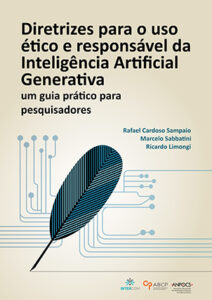Rafael Cardoso Sampaio, Professor of Politics, Federal University of Paraná (UFPR) e CNPq 1D productivity fellow, Curitiba, PR, Brazil
Marcelo Sabbatini, Professor of the Education Center and of the Matemathics and Technological Education Post-Graduate Program, Federal University of Pernambuco (UFPE), Recife, PE, Brazil
Ricardo Limongi, Professor of Marketing and Artificial Intelligence, Federal University of Goiás (UFG), Goiânia, GO, and Editor in Chief of the journal Brazilian Administration Review (BAR), Maringá, PR, Brazil

Image: Editora Intercom.
In our work Diretrizes para o uso ético e responsável da Inteligência Artificial Generativa: um guia prático para pesquisadores1 (Guidelines for the ethical and responsible use of Generative Artificial Intelligence: a practical guide for researchers), released by the publisher of the Brazilian Society for Interdisciplinary Communication Studies (Intercom), at the end of 2024, we sought to offer a solid reference for Brazilian researchers in a context of increasing adoption of Generative Artificial Intelligence (GenAI) tools.
Given the pointed absence of similar materials, the premise of the book is to establish parameters for incorporating this technology into research practices, contributing as a starting point for discussions or on the advancement of Artificial Intelligence culture in institutions.
The structure of the publication is based on two complementary dimensions: a normative aspect and a methodological-operational aspect. In the normative sphere, we establish principles such as methodological transparency–with an emphasis on full documentation of automated processes–the preservation of intellectual authorship and protection against the unsuitable misappropriation of data by international proprietary systems.
We seek to emphasize the centrality of human agency in research processes, such as the elaboration of the theoretical-methodological framework and the interpretative analysis of the results, and include understanding of GenAI tools, human authorship, transparency, integrity of academic research, plagiarism, originality and copyright, preservation of human agency, ethically oriented use, and AI literacy for researchers.
In the practical and methodological dimension, we present specific protocols for recurring challenges in contemporary academic practice. The book proposes methodologies for mitigating linguistic biases in automated bibliographic reviews and criteria for assessing textual quality in AI-assisted productions. We propose guidelines for the ethical treatment of sensitive data, including anonymization procedures and cross-validation between human and computer analyses.
The second, more practical part addresses activities typical of academic research, such as the initial exploration of ideas, searching for academic materials, reading and summarizing academic materials, writing, analyzing and presenting results, programming, transcription, translation, evaluation and assessment, selection, AI agents and, finally, the detection of text generated by GenAI.
We tried to illustrate the dilemmas with concrete examples presented in scientific literature and collected in our experience with examination boards and research groups. For example, we observed that AI-assisted literature reviews often disregard Brazilian sources, turning to articles in English, even when asked for sources in Portuguese.
Other than that, they may be limited to open-access articles, which do not always reflect the state of the art in a field. Another relevant example is the inattentive use of chatbots to write methodological sections, which can lead to the production of generic texts that do not capture the complexity of the data obtained.
Our guide also criticizes the false objectivity that AI detection tools propagate. With practical examples, we demonstrate how software such as GPTZero can fail to classify texts from non-native English-speaking researchers or those who adopt more succinct styles.
Instead of trusting these tools unconditionally, we suggest identifying discrete signs of artificial authorship, such as a lack of empirical examples or excessively broad citations. By doing so, we also advocate focusing on building a culture of academic integrity in which GenAI emerges as a tool.
Besides establishing guidelines, our book1 invites reflection on the role of GenAI in scientific research. We discuss how to balance efficiency gains with the preservation of creativity and the development of analytical skills. We propose that technology be integrated into more mechanical steps, such as grammar checking and organizing references, while preserving essentially human cognitive activities.
Lastly, we emphasize, firstly, the urgency of establishing Brazilian institutional guidelines, since the lack of regulations by CNPq (National Council for Scientific and Technological Development) and CAPES (Foundation for the Improvement of Higher Education Personnel) exposes researchers to the unstable policies of international and institutional companies.
Secondly, due to the very market logic that feeds the companies responsible for these models, we emphasize the importance of creating specific models for Brazilian science, running on “sovereign clouds” and preventing our most relevant results from being easily shared with such corporations.
The guide, therefore, does not seek to establish itself as the final word on a highly complex and ever-changing issue, but rather to make an invitation to universities, journals and funding agencies to jointly create a regulatory framework that protects the integrity of national research and, at the same time, consciously incorporates the transformative potential of generative AI.
The eBook can be downloaded for free (Portuguese only) at
Declaration on the use of generative artificial intelligence
This text was prepared and corrected with the help of DeepSeek (v. 3), Claude (version Sonnet 3.5) and MariTalk (version Sabiá 3) in January 2025. After using these tools, the authors have reviewed and edited the content in accordance with the scientific method and take full responsibility for the content of the publication.
Note
1. SAMPAIO, R.C., SABBATINI, M. and LIMONGI, R. Diretrizes para o uso ético e responsável da Inteligência Artificial Generativa: um guia prático para pesquisadores. São Paulo: Editora Intercom, 2024. Available from: https://www.portcom.intercom.org.br/ebooks/detalheEbook.php?id=57203
Reference
SAMPAIO, R.C., SABBATINI, M. and LIMONGI, R. Diretrizes para o uso ético e responsável da Inteligência Artificial Generativa: um guia prático para pesquisadores. São Paulo: Editora Intercom, 2024. Available from: https://www.portcom.intercom.org.br/ebooks/detalheEbook.php?id=57203
External links
Translated from the original in Portuguese by Lilian Nassi-Calò.
Como citar este post [ISO 690/2010]:








![How to translate academic writing into podcasts using generative AI [Originally published in the LSE Impact blog in June/2024] Image of a work of art made up of several lilac letters in a formation that looks like a cloud, generated by Google DeepMind](https://blog.scielo.org/en/wp-content/uploads/sites/2/2024/06/Text-To-Speech-LSE-Impact_thumb.png)








Recent Comments